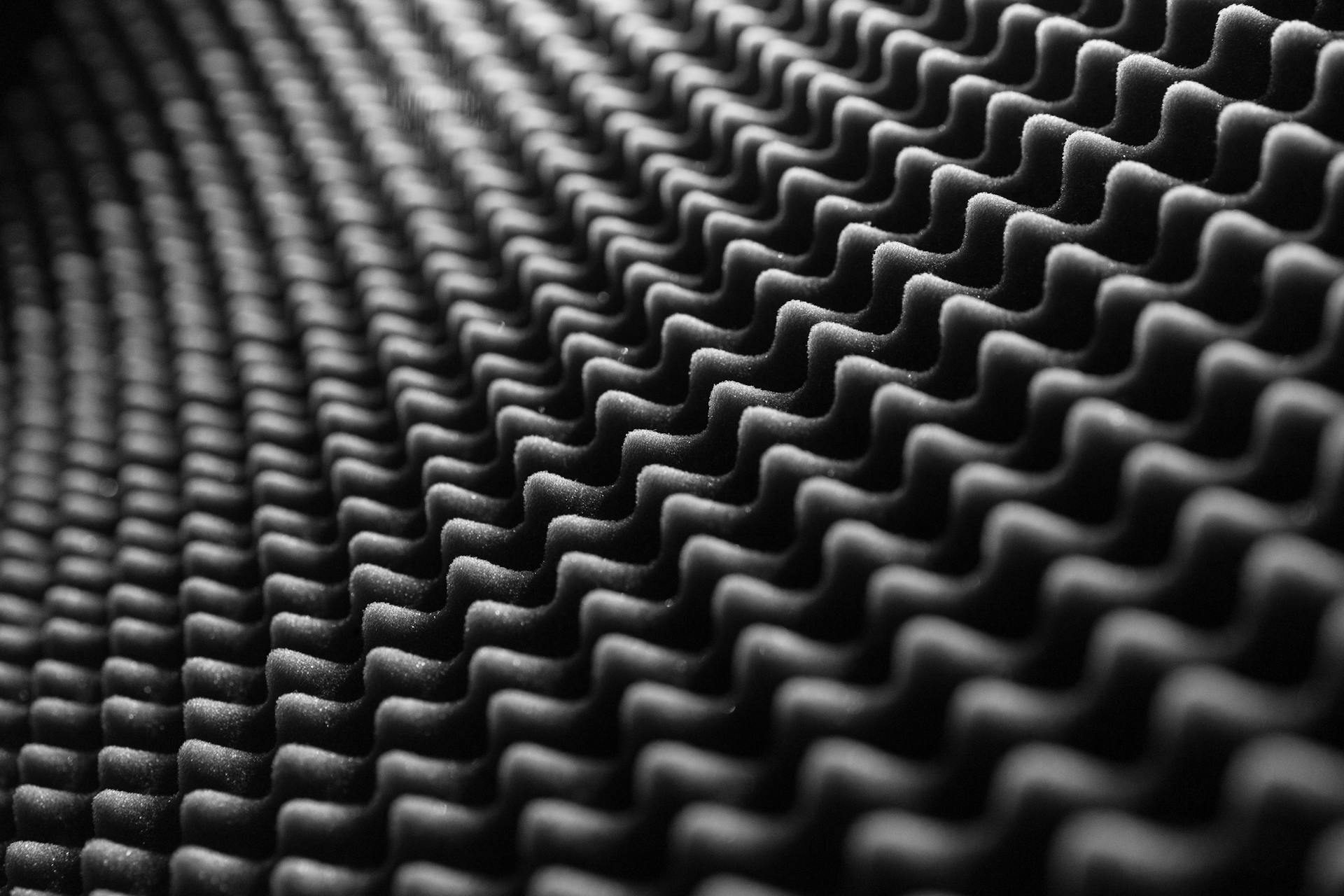
Soundproof egg crate foam is a game-changer for room acoustics and insulation. It's a type of acoustic foam that's designed to absorb sound waves, reducing echo and reverberation in a room.
This foam is made from a type of polyurethane foam that's specifically designed to be open-cell, allowing it to absorb sound waves more effectively. The egg crate pattern also helps to increase the surface area of the foam, making it even more effective at absorbing sound.
By using soundproof egg crate foam, you can significantly reduce the amount of sound that bounces around a room, creating a more peaceful and focused environment.
Choosing the Right Foam
Choosing the right foam for your soundproofing needs can be a bit overwhelming, but don't worry, it's easier than you think. Egg crate foam is a great option if you need to minimize high frequencies.
Egg crate foam is also ideal for small rooms, as it does well at reducing sound in these spaces. I've seen it used in home studios and it works like a charm. If you're experiencing echo-related issues, egg crate foam is a great choice, as it's great for echo noise reduction.

Here are some key differences between egg crate foam and pyramid foam to consider:
- Egg crate foam: minimizes high frequencies, ideal for small rooms, echo noise reduction, fast and affordable
- Pyramid foam: ideal for recording studios, absorbs sound and prevents it from intertwining with audio, works well for bass-related issues, thicker material that can reduce more sound
Ultimately, the choice between egg crate foam and pyramid foam comes down to your specific needs and preferences.
2 1/2" Acoustic
The 2 1/2" Acoustic Eggcrate Foam is a popular choice for its excellent deadening characteristics, making it a great option for soundproofing projects. It's available in two standard sizes: 72"x80" and 72"x48".
This foam type covers a significant area, with the 72"x80" sheet covering 40 sq. ft. and the 48"x72" sheet covering 48 sq. ft. when used in a 2-pack. The foam is cut slightly larger than the listed size to account for shrinkage during packaging and transit.
The 2 1/2" Acoustic Eggcrate Foam is available in all 13 colors, giving you a wide range of options to match your design. The foam has an Overall NRC (Noise Reduction Coefficient) of 0.60.
This foam meets ASTM E84 Class A and California 117 flame retardancy specifications, ensuring it will self-extinguish if exposed to a brief flame. However, it's essential to check building codes before installing the foam to ensure compliance with local regulations.
1-1/2" Charcoal 72"x80
The 1-1/2" charcoal eggcrate foam is a great option for those on a budget. It offers superior performance at an affordable price.

One of the advantages of this foam is its style, which keeps the price down. This makes it a more economical solution to soundproofing.
The 72" x 80" standard size is a great solution for a range of applications and projects. This size is perfect for covering large areas.
The color of this foam, charcoal, is especially appealing because it will hide dirt or stains. This makes it a great choice for those who want a clean and professional look.
This foam is made with the highest standards to ensure longevity and quality. You can count on it to perform well for a long time.
The standard sheet sizes of this foam are cut slightly larger than the listed size to compensate for shrinkage during packaging, transit, and delivery.
What to Choose
Choosing the right foam for your soundproofing needs can be a bit overwhelming, but don't worry, I'm here to help. You should choose egg crate foam if you need to minimize high frequencies, as it typically only focuses on high-frequency sounds.
If you're recording in a small room, egg crate foam is a great choice because it does well at reducing sound in a smaller space. I've seen it work wonders in home studios and practice rooms.
Egg crate foam is also a good option if you're experiencing an echo-related issue, as it's great for echo noise reduction. And if you're on a tight budget, egg crate foam is the way to go - it's fast, cheap, and gets the job done.
Here are some scenarios where egg crate foam might be the better choice:
Pyramid foam, on the other hand, is a better choice if you're producing audio and don't want the outer sound to reflect and mix with the audio. It does an excellent job at absorbing sound and keeping it from intertwining with the audio.
If you're willing to spend more money and want a thicker material that can reduce more sound, pyramid foam is the way to go. It's also a good option if you have a recording studio, as it's best for these types of spaces.
Pyramid foam is also a good choice if you're dealing with bass-related sounds, as it works well for bass-related issues.
Description
Our Charcoal Acoustic Egg Crate Foam is a great sound-proofing solution at a budget-conscious price. It's considered by many to be the best solution in value for sound-proofing.
The raised cone surface of the foam provides quick and clean sound absorption that you can count on when needed. This makes it a reliable choice for those looking to reduce echo and outside noise.
Foam is available in a combined thickness of 2-inch (1″ Cone 1″ Base) and 4-inch (2″ Cone 2″ Base), offering flexibility in terms of soundproofing needs. The 4-inch thick Charcoal foam provides superior soundproofing qualities when compared to the 2-inch thick foam.
Both options work exceptionally well when covered with an acoustical cloth for an added buffer. This helps to further reduce noise and create a more peaceful environment.
The foam is available in the color charcoal, which hides dirt and stains well, maintaining its pleasing appearance over time. This is a plus for those who want a foam that looks good as well as performs well.
It's worth noting that the foam is designed to be a long-lasting solution due to its durable construction and manufacturing process.
One Review

If you're looking for a one-stop shop for all your foam needs, consider the open-cell foam. It's a popular choice for many applications, including mattresses and pillows.
This type of foam has a higher breathability rating than closed-cell foam, allowing for better airflow and moisture wicking. It's also known for its pressure-relieving properties, making it a great option for people who suffer from back pain.
The density of open-cell foam is typically between 0.5-1.5 pounds per cubic foot, making it a versatile choice for a variety of uses.
Explore further: Green Cell Foam
Room Soundproofing
Soundproofing your room can be a game-changer for those who live in noisy areas or have noisy neighbors. You can achieve this with soundproof egg crate foam, a product that's easy to install and effective at reducing echo and sound distortion.
Egg crate foam is a great option for soundproofing because it's easy to install yourself. You can attach it to cardboard using glue, nails, adhesive, staples, or pushpins, and then attach the cardboard to the wall using adhesive.
Explore further: Polystyrene Foam Adhesive

To get the most out of egg crate foam, it's essential to cover the entire surface of the wall. Any gaps or cracks can allow sound to pass through, so make sure to use tape to seal any openings and cover the foam with blankets or curtains for extra soundproofing and a more attractive look.
Egg crate foam works best in smaller rooms and can only reduce a small amount of noise. However, it's a great starting point for beginners, and it's widely used by professionals and DIYers alike.
Here are some key pros and cons of using egg crate foam for soundproofing:
- Egg crate foam is easy to install yourself.
- It helps with echo and sound distortion.
- It's widely used for all types of rooms and professionals.
- It's very affordable.
- It's recommended for beginners.
- It's easy to find and purchase.
- Egg crate foam works best in smaller rooms.
- It can only reduce a small amount of noise.
- This type of foam is not very attractive or appealing.
- You may need to cover it with other fabrics to make it look better and give you an extra layer of soundproofing.
- This type of foam only works if the tiles are placed correctly.
- Egg crate foam cannot get much thicker to reduce more sound.
- It's better at absorbing higher sound frequencies than pyramid foam.
If you're looking for more information on using egg crate foam for soundproofing, check out Acoustic Fields' YouTube video, which provides details on closed- and open celled egg crate foam and how to properly use it in your room.
Frequently Asked Questions
What kind of foam is best for soundproofing?
For soundproofing, open-celled foam is ideal for low frequency sounds, while closed cell foam is better suited for high frequency sounds.
Sources
- https://www.thefoamfactory.com/acousticfoam/eggcratefoam.html
- https://www.decosoundpanel.com/resources/egg-crate-vs-pyramid-foam-what-should-you-choose.html
- https://myelearningworld.com/egg-crate-vs-pyramid-foam/
- https://foamonline.com/egg-crate/acoustic-egg-crate-foam/
- https://www.foambymail.com/product/1-5-eggcrate-foam.html
Featured Images: pexels.com


